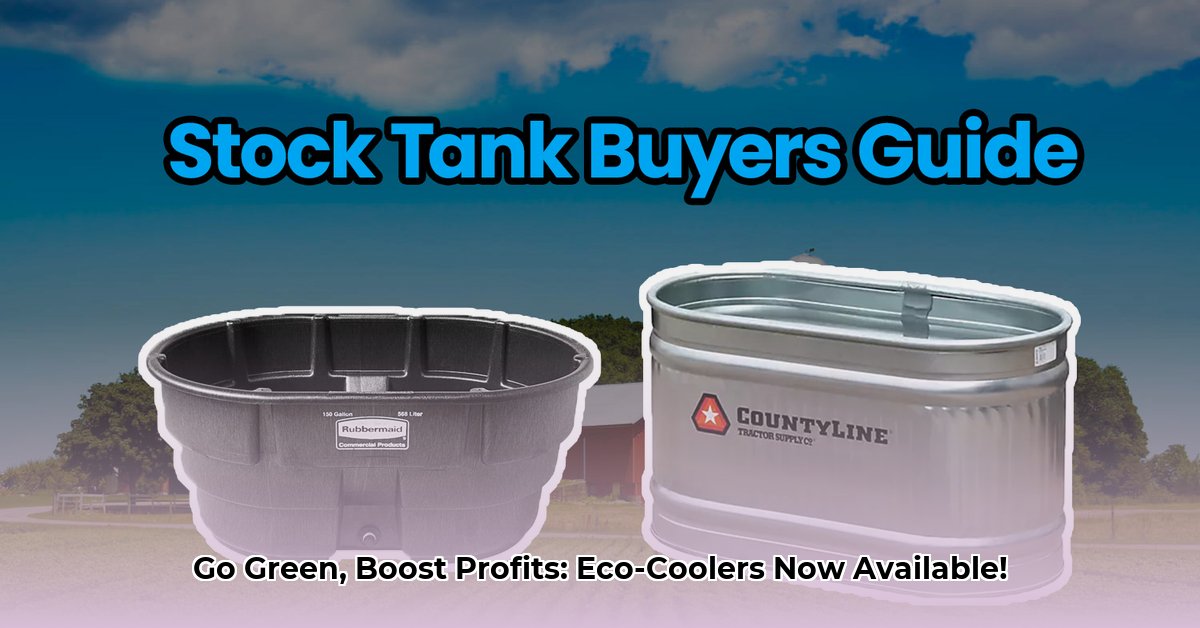
Finding the right cooling solution for your farm is crucial for preserving produce quality, maximizing profits, and minimizing your environmental impact. This guide will help you navigate the options available, focusing on energy efficiency and sustainability, even without specific Tractor Supply Co. product details. We'll explore various cooler types, provide practical steps for energy-efficient cooling, and highlight future trends in sustainable agricultural refrigeration. For more information on farm supplies, check out this Tractor Supply resource.
Choosing the Right Farm Cooler: Types and Considerations
Selecting the optimal farm cooler requires careful consideration of several factors. The ideal choice depends on your specific needs, budget, and climate. Let's analyze the main types:
Chest Coolers
Chest coolers are robust, simple, and typically budget-friendly. They're excellent for smaller operations and short-term storage of limited quantities of produce. However, their energy efficiency is lower compared to other options, limiting suitability for large-scale or long-term storage.
- Pros: Affordable, durable, easy to use.
- Cons: Inefficient for large volumes, short-term storage optimal.
Evaporative Coolers
These coolers utilize water evaporation to cool the air, often resulting in energy savings. Their effectiveness, however, is highly dependent on climate conditions. In dry, hot climates, they offer significant advantages, but their efficiency decreases considerably in humid environments. They are best suited for smaller operations requiring gentler cooling methods.
- Pros: Energy-efficient (in dry climates), naturally-cooling.
- Cons: Climate-dependent, less effective in humid areas.
Refrigeration Units
Refrigeration units are powerful and reliable, ideal for large-scale operations requiring precise temperature control and long-term storage. These units offer consistent performance, irrespective of climate, but consume substantial amounts of energy, resulting in higher operational costs.
- Pros: Powerful, consistent temperature control, suitable for long-term storage.
- Cons: High energy consumption, high initial investment.
Evaluating Energy Efficiency: A Practical Approach
Energy efficiency is paramount for both financial and environmental sustainability. While specific Tractor Supply Co. product data is unavailable, we can provide practical steps for assessing energy efficiency:
Energy Star Ratings (If Applicable): Look for Energy Star ratings when comparing similar models from different suppliers. This certification indicates that the cooler meets specific energy efficiency standards.
Insulation: Thicker, higher-quality insulation directly translates to reduced energy consumption. Pay close attention to the insulation quality when making a purchase.
Climate Considerations: A highly energy-efficient cooler in a mild climate may not perform as well in extreme heat. Factor in your local climate to estimate energy use.
Calculate Running Costs: Estimate the annual energy costs (electricity bills) for different coolers. Factor in your local electricity rates and the estimated daily runtime for each cooler type. A higher initial cost might prove economically beneficial in the long run due to reduced energy consumption. Don't just look at the initial price tag; consider the total cost of ownership.
Sustainable Cooling Practices: Minimizing Environmental Impact
Sustainable farming necessitates minimizing the environmental footprint of your cooling operations. Here’s how:
Choose Energy-Efficient Models: Prioritize high-efficiency coolers, even if the initial cost is higher. Long-term energy savings will compensate for this increased investment.
Harness Renewable Energy: Consider powering your cooler using solar energy. While the initial investment in solar panels is substantial, the long-term environmental and economic benefits are substantial.
Optimize Insulation: Ensure your cooler is properly insulated to minimize heat gain and reduce energy losses.
Implement Pre-Cooling: Pre-cool your produce before storing it to reduce the workload on your cooling system and extend product shelf life. This minimizes the overall energy needed for cooling.
Actionable Steps for Farmers: A Step-by-Step Guide
Let's translate the principles outlined into a practical action plan:
Assess Current Needs: Evaluate your current cooling requirements and energy usage. How much produce needs cooling? How long is the storage period? What are your current energy bills?
Identify Inefficiencies: Examine your present cooling system to pinpoint areas for improvement. Are you experiencing significant cold air loss? Is your current system struggling to maintain optimal temperatures?
Research Energy-Efficient Options: Research coolers from Tractor Supply and other reputable suppliers, comparing models based on energy efficiency, capacity, and features.
Calculate ROI: Compare the initial costs of different coolers with their long-term energy savings. The total cost of ownership (TCO) over several years is the key performance indicator (KPI).
Upgrade and Implement: Invest in a more energy-efficient cooler if necessary and implement other sustainable practices, such as pre-cooling and improved insulation.
Future Trends in Sustainable Farm Cooling
The field of agricultural cooling is constantly evolving. Advanced refrigeration technologies, such as magnetic refrigeration, are gaining traction, promising significantly increased energy efficiency. Emerging cooling methods continue to be developed. Stay updated on these advancements to access the latest, most sustainable solutions as they become available. The promise of innovation offers an optimistic outlook.
Conclusion: Building a Cooler, Greener Farm
Responsible cooling is crucial for sustainable and profitable agriculture. Making informed decisions regarding your farm’s cooling systems will positively impact your bottom line and the environment. Prioritize energy efficiency, sustainability, and continuous learning to build a more resilient and eco-friendly farm operation. Remember to conduct thorough research and engage with suppliers for detailed product information to support your informed decisions.